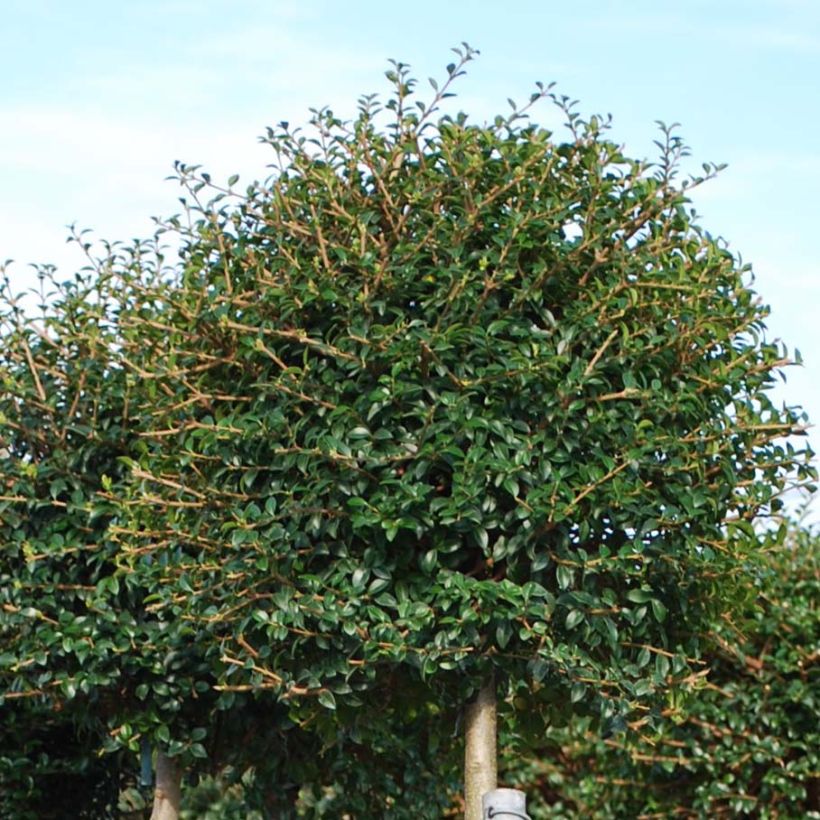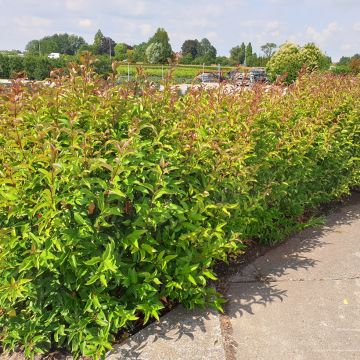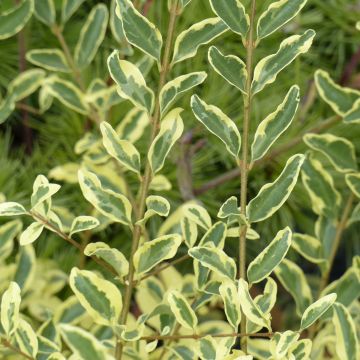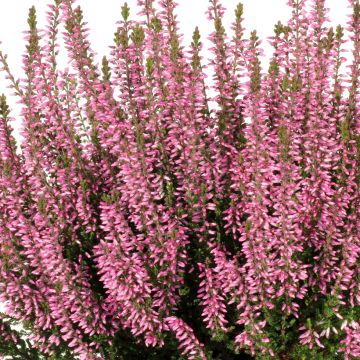

Ligustrum jonandrum - Yunnan Privet


Ligustrum jonandrum - Yunnan Privet


Ligustrum jonandrum - Yunnan Privet
Ligustrum jonandrum - Yunnan Privet
Ligustrum jonandrum
Delavay Privet, Yunnan Privet
I have received my two privet trees. One has its leaves while the other has practically none left. Since they are evergreens that I plan to plant side by side in large pots, I wonder if the second one will recover like the first one. Best regards
Françoise, 20/01/2024
This item cannot be shipped to the selected country
Delivery charge from €5.90
Delivery charge from €5.90
Delivery to Corse prohibited
More information
Schedule delivery date,
and select date in basket
This plant carries a 24 months recovery warranty
More information
We guarantee the quality of our plants for a full growing cycle, and will replace at our expense any plant that fails to recover under normal climatic and planting conditions.
From €5.90 for pickup delivery and €6.90 for home delivery
Express home delivery from €8.90.
From €5.90 for pickup delivery and €6.90 for home delivery
Express home delivery from €8.90.
Delivery to Corse prohibited: UE law prohibits the import of this plant from mainland France to Corse as part of the fight against Xylella fastidiosa. Please accept our sincere apologies.
More information
Does this plant fit my garden?
Set up your Plantfit profile →
Description
Ligustrum jonandrum, or more precisely Ligustrum delavayanum var. ionandrum, is a botanical species of Chinese origin that is sometimes called Yunnan privet. It is cultivated for its small, shiny green, dense foliage, and its excellent ability to withstand repeated pruning that allows its shape to be moulded according to the desires of each gardener. This highly branched bush is also very ornamental when it grows freely in a dense mass, wider than it is tall. Its honey-scented summer flowering gives way to blue-black berries that delight birds in winter. It is easy to grow in ordinary but well-drained soil. In colder regions it requires a sheltered exposure, as its average hardiness is one of its few weaknesses.
Yunnan privet belongs to the Oleaceae family, just like olives, forsythias, and jasmines. It is native, as its name suggests, to the Chinese province of Yunnan, but also to Burma. In nature, it most often grows on fresh, fertile, loamy-sandy or sandy-clayey soils. However, it is very tolerant, supporting slightly acidic, neutral, or even distinctly calcareous soils or even salt-impregnated soils from snow removal. It has a trailing root system, so voracious that it is often impossible to grow other plants at its base. When not pruned, it has a bushy and spreading habit, which is naturally compact. It will slowly reach an average height of 1.80 m (5.9 ft) with a spread of 2.50 m (8. ft). Its flexible, slender branches, which tend to intertwine, bear very small evergreen leaves. The leaves are single, opposite, elliptical in shape, and a fairly dark green colour with a shiny finish. Flowering takes place in late spring or summer, from May to July, in the form of fragrant terminal panicles, composed of small tube-shaped flowers. The flowers are white with a tinge of purple, and are popular with pollinating insects. They are followed by the formation of small fruits called drupes that turn black-blue at maturity.
Yunnan privet is perfect in any space. It brings a precise, orderly, reassuring note to the structure of a garden, and quickly adds life to neglected areas. Its flowering, fruits and foliage will provide interest all year round, and a home for many small animals that are useful in the garden. For the artistic gardener, it is perfect for the creation of topiary features. It also has the benefit of providing privacy against prying eyes! You can let it grow freely, in a grove of colourful shrubs, such as viburnum, cotoneaster, pyracantha, holly, eleagnus, deciduous or evergreen euonymus, brooms, bay laurel and cherry laurel. Be inspired!
Report an error about the product description
Ligustrum jonandrum - Yunnan Privet in pictures




Plant habit
Flowering
Foliage
Botanical data
Ligustrum
jonandrum
Oleaceae
Delavay Privet, Yunnan Privet
China
Other Ligustrum - Privet
Planting and care
In mild climates, plant Ligustrum jonandrum in spring or autumn. Choose regular but well-prepared and well-drained soil. It is not very demanding in terms of soil pH, but it will prefer a soft and deep soil that remains slightly moist in summer. Its hardiness is limited, around -13° C (8.6° F). In colder regions, choose a sunny or semi-shaded location, but well sheltered from dry and cold winds. Dig a hole twice and a half the size of the pot, loosen the bottom and add a large handful of potting soil or mix slow-release fertiliser with loose soil. Water well, especially during the first summers, mulch the soil to retain moisture, and prune the branches in half to encourage new shoots. Then, every year, prune the new shoots in half to promote branching of your young plant.
Container cultivation is possible, but it requires more frequent watering, shaping through pruning twice a year, and an even more sheltered location from severe frost.
Privets are quite resistant to pests and diseases. However, they can be affected by weevil larvae or caterpillars.
Planting period
Intended location
Care
-
, onOrder confirmed
Reply from on Promesse de fleurs
Evergreen shrubs
Haven't found what you were looking for?
Hardiness is the lowest winter temperature a plant can endure without suffering serious damage or even dying. However, hardiness is affected by location (a sheltered area, such as a patio), protection (winter cover) and soil type (hardiness is improved by well-drained soil).

Photo Sharing Terms & Conditions
In order to encourage gardeners to interact and share their experiences, Promesse de fleurs offers various media enabling content to be uploaded onto its Site - in particular via the ‘Photo sharing’ module.
The User agrees to refrain from:
- Posting any content that is illegal, prejudicial, insulting, racist, inciteful to hatred, revisionist, contrary to public decency, that infringes on privacy or on the privacy rights of third parties, in particular the publicity rights of persons and goods, intellectual property rights, or the right to privacy.
- Submitting content on behalf of a third party;
- Impersonate the identity of a third party and/or publish any personal information about a third party;
In general, the User undertakes to refrain from any unethical behaviour.
All Content (in particular text, comments, files, images, photos, videos, creative works, etc.), which may be subject to property or intellectual property rights, image or other private rights, shall remain the property of the User, subject to the limited rights granted by the terms of the licence granted by Promesse de fleurs as stated below. Users are at liberty to publish or not to publish such Content on the Site, notably via the ‘Photo Sharing’ facility, and accept that this Content shall be made public and freely accessible, notably on the Internet.
Users further acknowledge, undertake to have ,and guarantee that they hold all necessary rights and permissions to publish such material on the Site, in particular with regard to the legislation in force pertaining to any privacy, property, intellectual property, image, or contractual rights, or rights of any other nature. By publishing such Content on the Site, Users acknowledge accepting full liability as publishers of the Content within the meaning of the law, and grant Promesse de fleurs, free of charge, an inclusive, worldwide licence for the said Content for the entire duration of its publication, including all reproduction, representation, up/downloading, displaying, performing, transmission, and storage rights.
Users also grant permission for their name to be linked to the Content and accept that this link may not always be made available.
By engaging in posting material, Users consent to their Content becoming automatically accessible on the Internet, in particular on other sites and/or blogs and/or web pages of the Promesse de fleurs site, including in particular social pages and the Promesse de fleurs catalogue.
Users may secure the removal of entrusted content free of charge by issuing a simple request via our contact form.
The flowering period indicated on our website applies to countries and regions located in USDA zone 8 (France, the United Kingdom, Ireland, the Netherlands, etc.)
It will vary according to where you live:
- In zones 9 to 10 (Italy, Spain, Greece, etc.), flowering will occur about 2 to 4 weeks earlier.
- In zones 6 to 7 (Germany, Poland, Slovenia, and lower mountainous regions), flowering will be delayed by 2 to 3 weeks.
- In zone 5 (Central Europe, Scandinavia), blooming will be delayed by 3 to 5 weeks.
In temperate climates, pruning of spring-flowering shrubs (forsythia, spireas, etc.) should be done just after flowering.
Pruning of summer-flowering shrubs (Indian Lilac, Perovskia, etc.) can be done in winter or spring.
In cold regions as well as with frost-sensitive plants, avoid pruning too early when severe frosts may still occur.
The planting period indicated on our website applies to countries and regions located in USDA zone 8 (France, United Kingdom, Ireland, Netherlands).
It will vary according to where you live:
- In Mediterranean zones (Marseille, Madrid, Milan, etc.), autumn and winter are the best planting periods.
- In continental zones (Strasbourg, Munich, Vienna, etc.), delay planting by 2 to 3 weeks in spring and bring it forward by 2 to 4 weeks in autumn.
- In mountainous regions (the Alps, Pyrenees, Carpathians, etc.), it is best to plant in late spring (May-June) or late summer (August-September).
The harvesting period indicated on our website applies to countries and regions in USDA zone 8 (France, England, Ireland, the Netherlands).
In colder areas (Scandinavia, Poland, Austria...) fruit and vegetable harvests are likely to be delayed by 3-4 weeks.
In warmer areas (Italy, Spain, Greece, etc.), harvesting will probably take place earlier, depending on weather conditions.
The sowing periods indicated on our website apply to countries and regions within USDA Zone 8 (France, UK, Ireland, Netherlands).
In colder areas (Scandinavia, Poland, Austria...), delay any outdoor sowing by 3-4 weeks, or sow under glass.
In warmer climes (Italy, Spain, Greece, etc.), bring outdoor sowing forward by a few weeks.























































